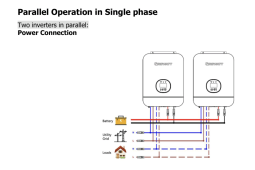mike616
New Member
I have 2x 3kW Growatt inverters and 2x 24v 200Ah LiFePO4 batteries on my RV. Where I will be staying for the next month, there is virtually zero direct sunlight available to my PV array. I am attempting to charge my batteries with a few hours of generator every day.
I am experiencing some strange overload situations with my setup. Both RV Air Conditioners have soft starts on them. But if I am using the generator, whenever I start one of the ACs, the inverter powering that load goes into overload (not the generator). If I set the battery charging current below 22A, I have no issues running one AC. But if I set it to 30A, as soon as the AC turns on, the load on the inverter reads about 5kW and goes into overload mode. There is nothing running in my RV that would be pulling that much load on one leg. In fact, if the AC really were drawing that much power, I would expect the 20A breaker at the RV's service panel to trip. Furthermore, the generator is only rated for 4050W max surge power and it is not overloading.
I have had no issues running one or both ACs on battery power or shore power.
There appears to be some relationship between the battery charge current and the load on the inverter. I was under the assumption that battery charge didn't get factored into the load on the inverter. In fact, with the battery charging at 22A and the AC off, the inverter load is at about 1%. But even if charging power is factored into the load, I should be under the inverter power rating:
(Battery charging power) + (AirCon Running Power) + (Residual Load) = Total Load
(24V * 30A) + (1400W) + (50W) = 2170W
I have no idea why the inverter running the AC is going into overload or why it thinks there is a 5kW load. Is there something I'm missing here?
I am experiencing some strange overload situations with my setup. Both RV Air Conditioners have soft starts on them. But if I am using the generator, whenever I start one of the ACs, the inverter powering that load goes into overload (not the generator). If I set the battery charging current below 22A, I have no issues running one AC. But if I set it to 30A, as soon as the AC turns on, the load on the inverter reads about 5kW and goes into overload mode. There is nothing running in my RV that would be pulling that much load on one leg. In fact, if the AC really were drawing that much power, I would expect the 20A breaker at the RV's service panel to trip. Furthermore, the generator is only rated for 4050W max surge power and it is not overloading.
I have had no issues running one or both ACs on battery power or shore power.
There appears to be some relationship between the battery charge current and the load on the inverter. I was under the assumption that battery charge didn't get factored into the load on the inverter. In fact, with the battery charging at 22A and the AC off, the inverter load is at about 1%. But even if charging power is factored into the load, I should be under the inverter power rating:
(Battery charging power) + (AirCon Running Power) + (Residual Load) = Total Load
(24V * 30A) + (1400W) + (50W) = 2170W
I have no idea why the inverter running the AC is going into overload or why it thinks there is a 5kW load. Is there something I'm missing here?



